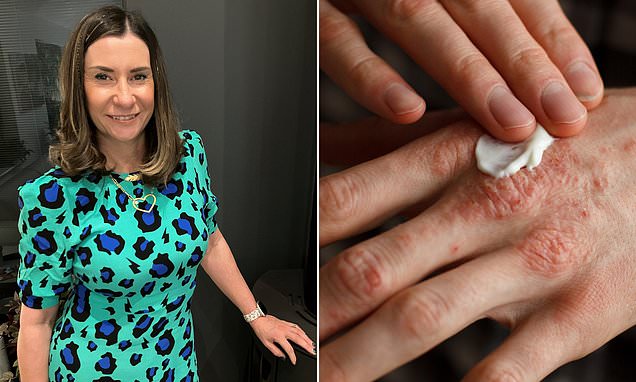Demands for traffic-light labels to show strength of steroid eczema cream… as experts say it will end confusion around drugs used by millions
- Experts say eczema ointment should be rated to avoid confusion over strength
Tubes of eczema ointment should be branded with traffic-light ratings to end confusion about how strong they are, say experts.
The medications, called topical steroids, are relied on by millions Britons – and are a mainstay of treatment for the condition, which causes the skin to become itchy, dry and cracked. But campaigners say patients are ‘flying blind’ with no easy way of knowing their potency, because, surprisingly, the strength of the drugs is never printed on packaging and rarely in the accompanying patient information leaflet.
Doctors say some patients are unknowingly over-using powerful versions, increasing the risk of agonising withdrawal symptoms when the course of treatment ends.
These include redness, ‘burning’ pain, excessive skin flaking and severe itching, which patients say are different from normal eczema flare ups – and can be so severe, they trigger insomnia and mental health problems such as anxiety and depression.
Meanwhile, experts say others apply too little as they are unduly worried about side effects, meaning their skin problems are not properly controlled.

ITCHING FOR CHANGE : Lifelong eczema sufferer Ellen Vincent
Such is the concern that the National Eczema Society last week wrote to the Medicines and Healthcare Products Regulatory Agency (MHRA) urging it to ‘mandate pharmaceutical manufacturers to introduce clear potency labelling on topical steroid tubes, packaging and patient information leaflets’.
Also signed by the British Association of Dermatologists, the open letter continued: ‘The goal is to achieve a level of public understanding comparable to sunscreen strength using the Sun Factor Protection (SPF) labelling.’
Andrew Proctor, chief executive of the National Eczema Society, said: ‘It’s left to healthcare professionals to explain about potency,’ he said. ‘There isn’t always time during busy consultations or patients may not remember. A packet of paracetamol tells exactly how much you can safely take – it should be the same for topical steroids. At the moment eczema patients are flying blind.’
The condition affects one in five children and one in ten adults in the UK. It occurs due to both genetics and environmental factors such as allergies, and is incurable.
Topical steroids – also known as corticosteroids – reduce inflammation, suppress overactivity of the immune system and narrow the blood vessels, which helps relieve some symptoms, such as itching and pain, alleviating the urge to scratch so the skin can heal. There are more than 100 different types of topical steroid preparations available in the UK, broadly grouped into four categories of potency: mild, moderate, potent and very potent.
IT’S A FACT
Roughly a third of children with atopic eczema will also develop asthma and/or hayfever, according to the British Skin Foundation.
A moderately potent steroid is twice as strong as hydrocortisone one per cent – the mild type – and both are available over-the-counter. Potent steroids are ten times the strength and very potent ones are at least 50 times stronger.
But this basic information is not on packaging – instead, the concentration of active ingredients is printed, usually in per cent. But the potential for confusion is clear: for instance, betametasone 0.1 per cent is a potent steroid that’s ten times the strength of hydrocortisone one per cent.
Professor Celia Moss, consultant dermatologist at Birmingham Women’s and Children’s NHS Foundation Trust, said it was ‘a mystery’ as to why drug firms didn’t make things clearer. She said: ‘A few years ago, the MHRA ruled all skin lotions containing paraffin should have a fire risk warning on the packaging, despite that risk being very small. They need to do something similar to address the confusion about topical steroid strengths.
‘A traffic-light-style system would be great, as we’re used to them on food packaging.’
Labels could indicate green for the mildest formulas, amber for moderate, red for potent and darker red for very potent.
Topical steroids are typically meant for short-term use of between two and six weeks. For the majority of eczema patients, symptoms will ease in this time. Those with more severe eczema may need to use stronger creams over longer periods which requires monitoring as the risk of side effects increases.
A 2021 MHRA review said withdrawal could occur ‘after long-term continuous or inappropriate use of moderate to high potency products’.
Professor Anthony Bewley, of the British Association of Dermatologists and a consultant dermatologist at Barts Health NHS Trust, said: ‘A minority of patients using topical steroids find their skin gets worse, not better, and need to apply more. When they stop they suffer severe skin problems. We don’t know why but it is mainly seen in people using potent topical steroids for years without supervision.
‘Instructions can be vague – leaflets talk of applying “sparingly” or “enough to cover the affected area” which isn’t good enough.’
Topical steroid doses are measured in ‘finger tip units’, or FTUs. One FTU – enough ointment to cover the end of an adult finger from tip to crease of the first joint – should be applied to an area of skin the size of two adult hands with the fingers held together.
‘Using less can mean symptoms aren’t controlled, so the patient uses more for a longer time, increasing risks,’ said Prof Bewley.

The medications, called topical steroids, are relied on by millions Britons – and are a mainstay of treatment for the condition, which causes the skin to become itchy, dry and cracked (file photo)
Prof Moss said there is also an issue with patients avoiding using steroids due to fears of extreme withdrawal symptoms.
Studies suggest that up to eight in ten have concerns about using topical steroids.
‘It’s a problem with people unwilling to use even mild topical steroids, even if they would benefit, as they’ve read about withdrawal symptoms,’ Prof Moss added. ‘Better labelling would help.’
A survey by the National Eczema Society found just 17 per cent of eczema sufferers knew how many strengths of topical steroid there are.
One eczema sufferer who understands the confusion is Ellen Vincent, who was diagnosed as a child.
The 43-year-old, who lives in Cheltenham, Gloucestershire, said: ‘Like many eczema sufferers, I use different strength topical steroids on different body parts.
‘At times, I’ve been using three at once and can get confused. There is a risk you accidentally use a strong one where you should use a mild one, and vice versa. The tubes often look very similar.
‘Better labelling on the packaging would help a lot.’
Source: Read Full Article
